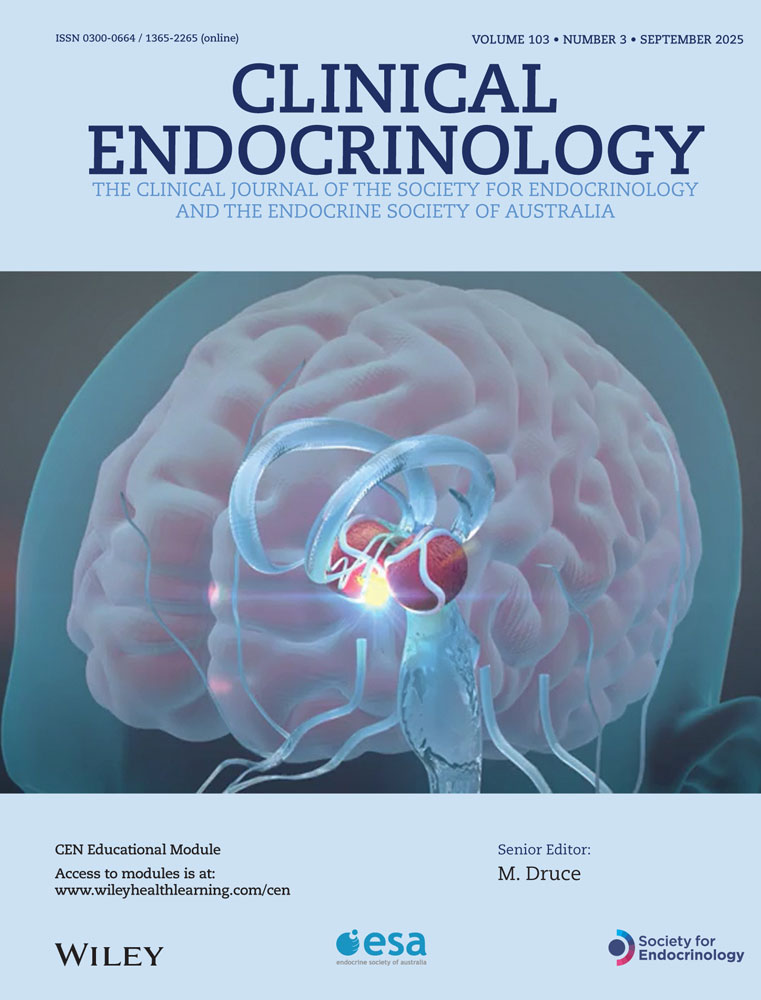Thyroid function in the newborn in relation to maternal thyroid status during labour in a mild iodine deficiency endemic area in Sudan
Abstract
OBJECTIVES Data on neonatal and maternal thyroid function during labour in a mild iodine deficiency endemic area are lacking. The current study focuses on elucidating the thyroid function during labour, in a group of pregnant women who live in an area of mild iodine deficiency in Sudan compared to that observed in their corresponding newborns.
MEASUREMENTS Serum concentrations of TSH, thyroglobulin (Tg), triiodothyronine (T3) and free thyroxine (FT4) were investigated during labour in a group of mothers and their neonates residing in an area with mild iodine deficiency in Sudan (n = 76 mother–newborn pairs).
DESIGN Maternal blood samples were taken on two occasions: first, during the third trimester of pregnancy (weeks 32–39); and, second, just before delivery. Cord blood samples were obtained by a doctor or a trained midwife during delivery.
RESULTS The median concentrations (and interquartile ranges) of neonatal TSH, Tg, T3 and FT4 were 6·8 (4·7–12·4) mU/l, 61 (40·2–98·2) µg/l, 0·9 (0·8–1·2) nmol/l and 14·2 (13·4–15·9) pmol/l, respectively. The corresponding levels for the mothers during labour were 2·3 (1·9–3·2) mU/l, 33 (15·0–56·8) µg/l, 2·6 (2·0–2·9) nmol/l and 11·4 (10·3–13·3) pmol/l, respectively. The median neonatal serum concentrations of TSH, Tg and FT4 were significantly higher than the corresponding maternal levels (P < 0·0001, P < 0·0001, P < 0·0001, respectively). In contrast, the median maternal serum concentration of T3 was significantly higher than that of the neonates (P < 0·0001). When the different neonatal thyroid parameters were compared with each other, significant correlations were observed between TSH and FT4 (r = 0·4, P = 0·001); Tg and T3 (r = −0·3, P = 0·04) and Tg and FT4 (r = 0·5, P = 0·0001). Women with Tg concentrations above 20 µg/l showed a higher median TSH concentration and lower median FT4 concentration than those with Tg concentrations below 20 µg/l (P < 0·001, P < 0·001, respectively). Nevertheless, the thyroid function of neonates born of mothers with elevated Tg was similar to that of neonates born of mothers with low Tg levels. No significant changes had occurred in the thyroid function parameters between the third trimester of pregnancy and during the time of labour. The thyroid function indicators of the babies born by vaginal delivery did not differ significantly from those of the babies born by Caesarian section.
CONCLUSIONS The study suggests that, in areas with mild iodine deficiency, neonates may be at the limit of decompensation as evidenced by their enhanced TSH and Tg levels as well as increased T4 compared to their mothers. This finding must not create a false sense of well-being and points rather to the urgency of iodine supplementation of mothers even in areas with mild iodine deficiency, as in this part of Sudan. The mode of delivery, whether by spontaneous vaginal delivery or Caesarian section, did not seem to affect the thyroid function of the newborn.




